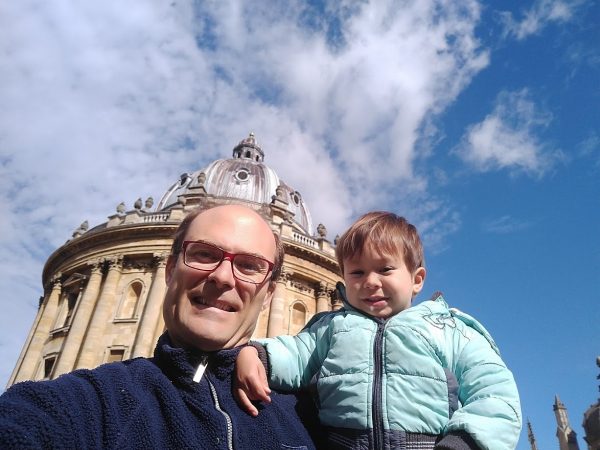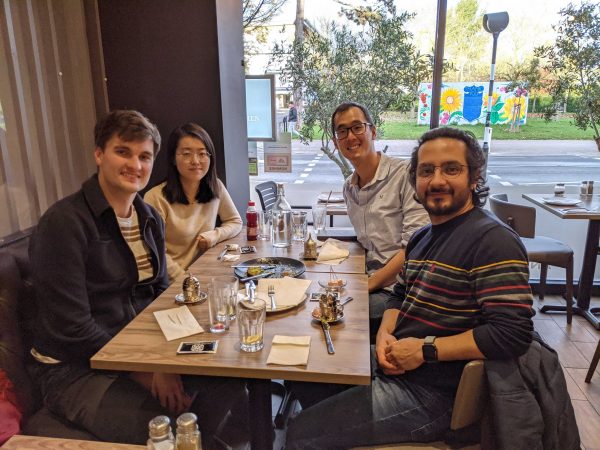By Mathieu Boudreau

This MRM Highlights Pick interview is with Aaron T. Hess and Mark Chiew, researchers at the University of Oxford in the United Kingdom. Their paper is entitled “Accelerated calibrationless parallel transmit mapping using joint transmit and receive low-rank tensor completion”. Their paper was chosen because, in it, the authors demonstrated exemplary reproducible research practices; in particular, they shared all the scripts and data required to reproduce every figure published in the paper.
To discuss this Q&A, please visit our Discourse forum.
MRMH: Could you each tell us a bit about yourself and your background?
Aaron: I grew up in Zimbabwe. I’ve always enjoyed making and building things and seeing how things work, and so, at the University of Cape Town, I chose to do electrical engineering. That’s where I was introduced to MRI as a field of interest, and I went on to do a master’s degree and PhD in MRI and MRS. I’ve always been really fascinated by motion in the MRI scanner, like what you see when something moves in the heart or the brain. So, in the last 10 years, I’ve been doing 7T MRI in the heart, which has been fabulously intriguing. And I’ve recently shifted roles from doing research to being a support physicist.
Mark: I did my undergrad at the University of British Columbia, in engineering physics. I was first exposed to MRI through a summer co-op term where I worked for a pediatric research lab that used fMRI. At that point, I had actually had no real involvement in the imaging, I was basically just doing grunt work for the lab. But it gave me that first exposure needed to trigger my interest in MRI. So, I went and did a PhD in medical biophysics at the University of Toronto, working on methods for real-time fMRI. And then, in 2012, I moved to Oxford to work on low-rank methods for fMRI. In the last few years, I’ve shifted emphasis towards more fundamental image reconstruction problems using low-rank methods and exploring the space of image acquisition and reconstruction.
MRMH: Before we dive into your paper, could you maybe unpack the term “low-rank tensor completion” used in your title?
Mark: Sure – the easiest way to think about tensors is to think of them as multi-dimensional arrays. For example, matrices can be viewed as two-dimensional arrays with rows and columns, and tensors are just a multi-dimensional generalization of that concept. A tensor is essentially a mathematical construct that we use to organize or structure data. It is quite convenient, because we can use it to exploit redundancy in the dataset across all of these dimensions, and that is where the low-rank concept comes into play. So, whether it’s a tensor with dimensions of space and time, or coils and echoes, or contrasts and TEs, or any combination of these different dimensions, we can take this tensor and exploit redundancies or correlations in the data that we’ve rearranged into what’s called a block-Hankel matrix. These structured matrices are just a particular way of reorganizing the k-space data within the tensor to more easily exploit linear inter-depencies.
MRMH: Great, thanks! And I just wanted to thank you for your attention to detail when creating Figure 1 in your paper, as the visual support it provided helped me to understand much better how you constructed the block-Hankel matrix.
Mark: Thanks for noticing that! It was very important to me that the figure be a true representation of what was actually happening, because I too have been in the situation of trying to understand a paper and struggling to understand the math, and if the illustration accompanying the text doesn’t exactly follow the description, it’s very frustrating.
MRMH: Could give us a brief overview of the paper?
Aaron: So, the problem I was interested in when starting to work on this paper was how to measure transmit field maps in the heart for parallel transmit applications. Parallel transmit is quite slow to map because you’ve got to map each channel by itself, and that means you can’t typically do it in a breath hold, which is a requirement for cardiac imaging. And we also have to be able to do parallel imaging on it, which means that you also need to measure receive sensitivities. We decided to investigate calibrationless methods, and it dawned on us that there must be extra redundancy in the data that could lead to accelerated acquisitions, because we were making multiple measurements across different transmitters. It wasn’t clear to us at first which matrix completion method was the appropriate one to use for this application, so we formulated our question differently, asking ourselves which, of three different methods, would be the right way. Should we consider it a purely parallel imaging problem, a purely parallel transmit problem, or a joint problem. Intuitively, we thought that approaching it as a joint problem would give us the best results, and indeed that’s what we found when we used Mark’s implementation of a joint transmit and receive low-rank tensor completion solution. Our results show that you can rapidly map your transmit array using the acceleration factors enabled with the joint approach, and this makes for much easier cardiac imaging.

Mark: One of the ways in which I like to think about where this data redundancy comes from is based on the fact that, for example in a parallel transmit system, we might have say eight transmit channels. And just for the sake of easy math, let’s say we’re working on an MRI system that has eight receive channels. If we’re going to acquire a set of images to map every transmit channel, we end up with 64 images, i.e., eight receive images for every transmit channel. But, if we think of how many independent degrees of freedom we have in that problem, it’s actually just 16 (8 receive channels plus 8 transmit channels). So clearly, there’s some redundancy there to be exploited, and that’s what we tried to do with our approach here.
MRMH: How does this work fit in with your broader research goals moving forward?
Mark: For me, the interesting thing here was essentially coming across an opportunity to explore new formulations for image reconstruction to explore how much value you can extract from as little data as possible. It posed a good problem for starting to play around with these structured low-rank tensor methods, with the aim of trying to find mechanisms where we could squeeze as much out of the data as possible. I see all this as an interesting set of puzzles just waiting to be solved.
Aaron: I think my angle is quite different, which is why I think Mark and I work well together. For me, it’s more about the application of these techniques, and the ability to now take this forward and use it clinically. The ability to rapidly measure transmit fields and streamline this process is a very useful ability to have. The intriguing aspect for me is establishing how little information about your transmit system you actually need in order to be able to adjust and calibrate it. And what this paper tells us is that there is actually only a tiny bit of data or information that you really need to measure in order to know what’s going on.
MRMH: For this paper, you shared all the code and data needed to reproduce all of your figures. What was your main motivation in doing so?
Mark: I think, in general, it’s part of a broader push within our community. It’s important for reproducibility concerns, but also very valuable for didactic reasons. If you’re just learning about these methods and these techniques for the first time, having the code there and readily available is hugely beneficial in my view, as it reduces the barrier to entry for newcomers in our field. I believe we’ll all benefit from this movement, as it creates this effect of a rising tide that lifts all boats. It’s also just good practice for us, because developing these scripts with a view to sharing was an incentive to document the code well, which you often don’t do when you know no one else will see it. Having scripts that reproduce all our work and our figures makes our research more self-contained and reproducible, and it’s very packageable. It’s basically everything you would want yourself when archiving work done in your own lab.
Aaron: I think for me, it’s the transparency aspect. I also think making research more transparent gives a lot more strength to your results.
MRMH: What do you enjoy doing when you’re not in the lab or doing research?
Aaron: I spend a lot of time with my young family. There’s a lot of countryside around Oxford with farms, parks, and zoos. So, there are plenty of fun things to do with children here.
Mark: I spend a lot of my free time with my family as well. I have two young kids and it’s just amazing to sort of watch them grow and play with them. When my kids are asleep, I like to play chess online and crossword puzzles, exciting things like that [laughs].




